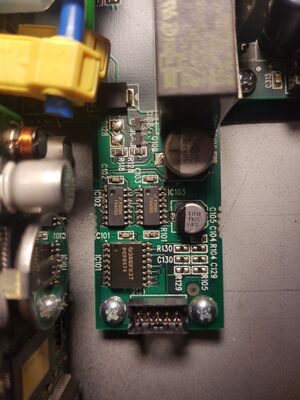APC7921
Contents
APC7921 overview
The APC7921 is an 8-port Power Distribution Unit where every port is switchable. It provides a way to control the outputs via serial and/or ethernet (10/100Base-TX). There is also a provision to sense and display the total amount of power going through the device via a current-transformer and a 2-digit 7-segment display.
A status-led provides extra device-status, a button allows for basic interaction. A pinhole-reset-button allows resetting the device without cutting power.
The front-panel
Front
- Ethernet w activity-leds
- Serial
- 2x 7-segment display
- 1x 3-color LED
- Button
- factor-reset-switch (hole)
- 8x female outlets
- 8x leds
- 1x male inlet
Schematic overview
FRONT
+---------------------------------------------------+-----+
| Controller | | | |
+-------------+ | Relay board | |
| IN OUT |J131 J132 | |
| +-----------------------------------+ |
| +-----------------------------+ |
| | PSU Board | |
| |J231 J266 | |
+---------------------+-----------------------------+------
BACK
Components overview
PSU module
PSU -> PSU -> controller wiring
The PSU board has two identical PSU's onboard that provide 24VDC The right-most PSU also has a set of pins used for connecting current-transformer circuitry to the controller. The left-most PSU only has 2 pins connected for 24VDC, nothing else.
PSU -> PSU -> controller wiring
10-wire flat-cable with 2mm pitch 2x5 connectors runs from J266->J231->Controller-IN See connector J266 and J231
Controller
The controller provides ethernet and serial connectivity; as well as a 2-digit display and a 3-color status-led to indicate errors and/or amperage. It also has a single button to interact with the device, as well as a pin-hole switch that allows for factory-resets.
Main things to replicate:
- 24VDC 'merging'
- Faulty PSU detection
- Ethernet function
- Serial function (if desired)
- 24VDC->3.3VDC conversion (for relay-board logic)
- I2C bus to control relay-board
- Adress-bus lines (can be hard-wired)
The controller drives the relay-board with a similar 10-conductor flatcable with 2x5pin 2mm headers.
It provides 24VDC and 3.5VDC power to the relay-board with seperate GND's.
It also provides an I2C bus (SDA/SCL) and 3 'address-lines'.
See connector J131
Relay board
There are 2 main parts to the relay-board. The IO-circuit and the relay-circuit.
Relay-board IO circuit
The relay-board uses a PCF8574 'Remote 8-Bit I/O Expander for I2C Bus' to provide 8 outputs that drive the relays. It is powered with 3.5VDC from the controller-board which creates it from the 24VDC available there. The PCF85674 has 3 address-strapping lines A0,A1,A2 that allow selecting the I2C slave-addresses for both READ or WRITE operations. See table later in the document. In single-board operation, strapping all pins to L would put the READ address at 0x41 and WRITE at 0x40 The relay-boards can be daisy-chained by connecting a next board to the J231 of the first. For this to work, however, at least one, and at most two, address-lines will need to be strapped H The reason for this is the manner in which the A0-A2 lines are presented on the J231 connector. They are shifted one pin,
Signal J131 +-------------+ J132 A0 7 ---------|---------+ +------ 7 A1 9 ---------|--+ +---------- 9 A2 10 ---------+ +----------------- 10
The PCF8574 provides 8 outputs that drive the relays using a circuit that first INVERTS the data via a NOR port (one pin strapped to ground, the other connected to the PCF8574) before running to one of the 8 relay-circuits that switch the 220VAC power provided to one of the 8 output terminals. The 8 NOR ports for this setup are provided by 2x 7402 IC's and seem to function both as a signal-conditioner as well as a way to ensure the power-on state is 'on' for each of the relay circuits (needs to be verified).
Relay-board relay circuit
Each of the 8 relay-circuits is identical and consists of:
- A small switching-transistor driven from a NOR-gate, switching 24VDC
- NMBT222A, marked 7CP
- A Relay-coil being driven by the switching-transistor
- A flyback diode across the relay in reverse-polarity for circuit-protection
- A smaller diode-array that seems involved in driving the LED somehow.
- BAV99, marked A7W
- An LED
- A series resistor to current-limit the LED
Pinouts of connectors
J266 PSU1
(right, next to current-transformers)
+----+
NC |10 9| NC
GND PSU1 |8 7| Sense Phase B
24VDC PSU1 |6 5| 24VDC PSU1
Center of 3phase |4 3| Sense Phase A
Center of 3phase |2 1| Sense Phase C
+----+
J321 PSU2
(left, on edge of board)
+----+
24VDC PSU2 |10 9| GND PSU 2
|8 7|
|6 5|
|4 3|
|2 1|
+----+
Note: GND PSU1 and GND PSU2 are connected together via screws that fasten PCB to chassis.
J131 Relayboard input
(on relais PCB , left side)
J131 and J132 +----+ |1 2| |3 4| |5 6| |7 8| |9 10| +----+ J131 PCF8574 1 GND IO 8 2 GND relais 3 VCC IO 16 4 SDA IO 15 5 24VDC relais 6 24VDC relais 7 A0 IO 1 8 SCL IO 14 9 A1 IO 2 10 A2 IO 3
J132, relay board OUT
On right side of relay board 1 GND IO 2 GND Relais 3 VCC IO 4 SDA IO 5 24VDC RELAIS 6 24VDC RELAIS 7 A2 IO 8 SCL IO 9 A0 IO 10 A1 IO
PCF 8574 DW (16 pin)
O = Pin 1 marker
+----------+
A0 -| 1 O 16 | VCC (2.5-6vdc)
A1 -| 2 15 |- SDA
A2 -| 3 14 |- SCL
P0 -| 4 13 |- _INT_
P1 -| 5 12 |- P7
P2 -| 6 11 |- P6
P3 -| 7 10 |- P5
GND -| 8 9 |- P4
+----------+
